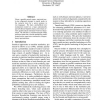Free Online Productivity Tools
i2Speak
i2Symbol
i2OCR
iTex2Img
iWeb2Print
iWeb2Shot
i2Type
iPdf2Split
iPdf2Merge
i2Bopomofo
i2Arabic
i2Style
i2Image
i2PDF
iLatex2Rtf
Sci2ools
EMNLP
2004
2004
Dependencies vs. Constituents for Tree-Based Alignment
Given a parallel parsed corpus, statistical treeto-tree alignment attempts to match nodes in the syntactic trees for a given sentence in two languages. We train a probabilistic tree transduction model on a large automatically parsed Chinese-English corpus, and evaluate results against human-annotated word level alignments. We find that a constituent-based model performs better than a similar probability model trained on the same trees converted to a dependency representation.
EMNLP 2004 | EMNLP 2007 | Parallel Parsed Corpus | Parsed Chinese-english Corpus | Tree Transduction Model |
| Added | 30 Oct 2010 |
| Updated | 30 Oct 2010 |
| Type | Conference |
| Year | 2004 |
| Where | EMNLP |
| Authors | Daniel Gildea |
Comments (0)

